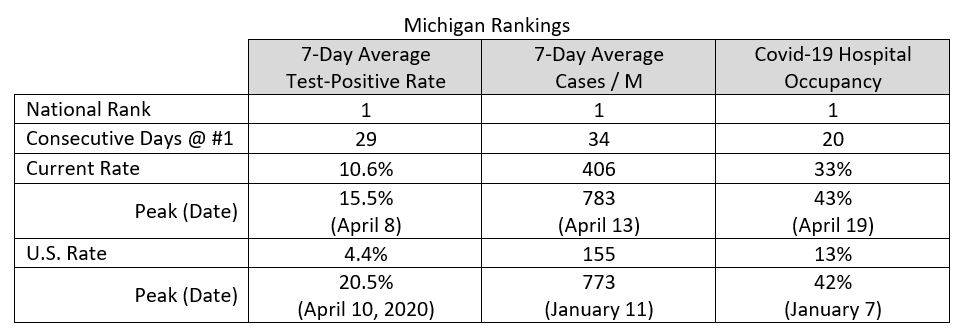
May 3, 2021 – Saturday was Graduation Day at the University of Michigan for the Class of 2021. Downtown Ann Arbor streets teemed in a way not seen in more than a year. Graduating seniors, and their proud parents, filled every outdoor restaurant table in town. Wearing caps and flowing gowns, countless seniors rode scooters with youthful energy throughout the city. Robbed of a typical senior years’ experience, these students embraced their rediscovered freedom. On this bright Saturday, the sense of liberty seemed more abundant than it had in a long time. Students shared a growing belief that the worst of the pandemic was over. People were confident in enjoying everyday activities.
Living on the skirts of downtown, we saw this phenomenon ourselves. Three neighbors on their way to dinner stopped to chat. They were giddy with the liberation afforded them by recent vaccinations. We were setting up an outdoor picnic with several other neighbors. The 147th running of the Kentucky Derby became an excuse to reconnect with friends. By the end of the race, the impromptu gathering swelled more than a dozen-and-a-half neighbors.
Are we back to normal? Not quite. Yet, the feeling was palpable. Normal may arrive soon, at least in this country.
In many respects, Michigan remains the epicenter of the COVID-19 pandemic in the United States. The state ranks first in the country in several measures:
- the 7-day average cases per capita,
- the share of hospital beds occupied by Covid-19 patients,
- and the percentage of positive Covid-19 tests over the last seven days.
Moreover, Michigan has a vice grip on these dubious rankings. The state has led the nation in the daily case rate for 34 days. Its Covid-19 hospital occupancy has ranked number one for the last 20 days. Its positive test rate has been the highest in the country each of the past 29 days.

Michigan’s recent progress symbolizes what is occurring elsewhere in the country. The state has sliced its case rate in half in three weeks. Further, the Institute for Health Metrics and Evaluation (IHME) expects this rate to be cut in half again in the next 16 days. It anticipates another, similar cut in the following two weeks. For those keeping track, that’s an eightfold rate drop in a month-and-a-half.

Michigan has also seen declining COVID-19 hospitalizations and positive-test rates. The state’s COVID-19 patient census peaked three weeks ago. One-quarter fewer patients occupy Michigan hospital beds than twenty-one days ago.
The state shrunk its positive test rate by one-third during this time. The daily rate was below the benchmark 10% each of the past two days. The state had not accomplished that feat in at least a month.
What about the U.S. experience? Here, the progress has been more substantial. The national 7-day new case rate fell yesterday to its lowest level in seven months. Since peaking in early January, this rate has fallen by 80%.
The Center for Disease Control and Prevention (CDC) reminds us that most infections go undetected. By some estimates, actual infections outnumber detected cases by three to four times.
So, what’s the view from an actual infection perspective? Even brighter than it is from that of detected cases.
Scientists from Harvard, Stanford, and Yale maintain a model to estimate daily infections. Their latest modeling suggests that daily infections peaked in the U.S. on January 2. After declining 117 straight days, estimated daily infections are now seven times lower than at the beginning of the year. Moreover, the U.S. may be witnessing fewer new infections each day than any time since March 14, 2020.
IHME predicts that COVID-19 infections nationally will be cut in half in the next twenty days. It expects another halving in this rate during the following eighteen days.
With declining new infections, deaths with COVID-19 are reaching new lows too. The 7-day average reported deaths dropped to their lowest level in more than nine months. IHME expects the number of deaths to be cut in half this month and in half again in June.
A robust vaccination program delivered the improvement we have seen in this country. Among large nations, only Israel and the United Kingdom exceed the U.S.’s share of vaccinated persons. Senior citizens have set a strong pace in this country, with nearly 70% already finishing their vaccinations. Another 13% only need their second shot.
Younger adults have not been as enthusiastic about getting vaccinated. As a result, vaccinations are slowing in this country. Fewer than half of adults between 18 and 64 years of age have even started getting vaccinated. Only one-third of younger adults have received all required doses.
The seven-day average vaccination rate has dropped 25% in the past 16 days, to 2.5 million.
So, the U.S. COVID-19 outlook is as bright as the Ann Arbor skies on Graduation Day. Still, longtime Michigan residents understand the risks of pop-up storms developing off the Great Lakes. In much the same way, a less-than-complete vaccination effort means we cannot ignore the risk of new infections.
Nonetheless, after a long, cold winter, the sunshine and the time with friends are welcome.
Contributing writer:
Mark A. Van Sumeren, strategic advisor, Medical Devices & Integrated Delivery Networks
Health Industry Advisor LLC, provides a regular report on COVID-19 numbers for the health care industry.
For more information, or to sign up for the report, contact Mark at Mark.VanSumeren@HealthIndustryAdvisor.com; or visit www.HealthIndustryAdvisor.com.
